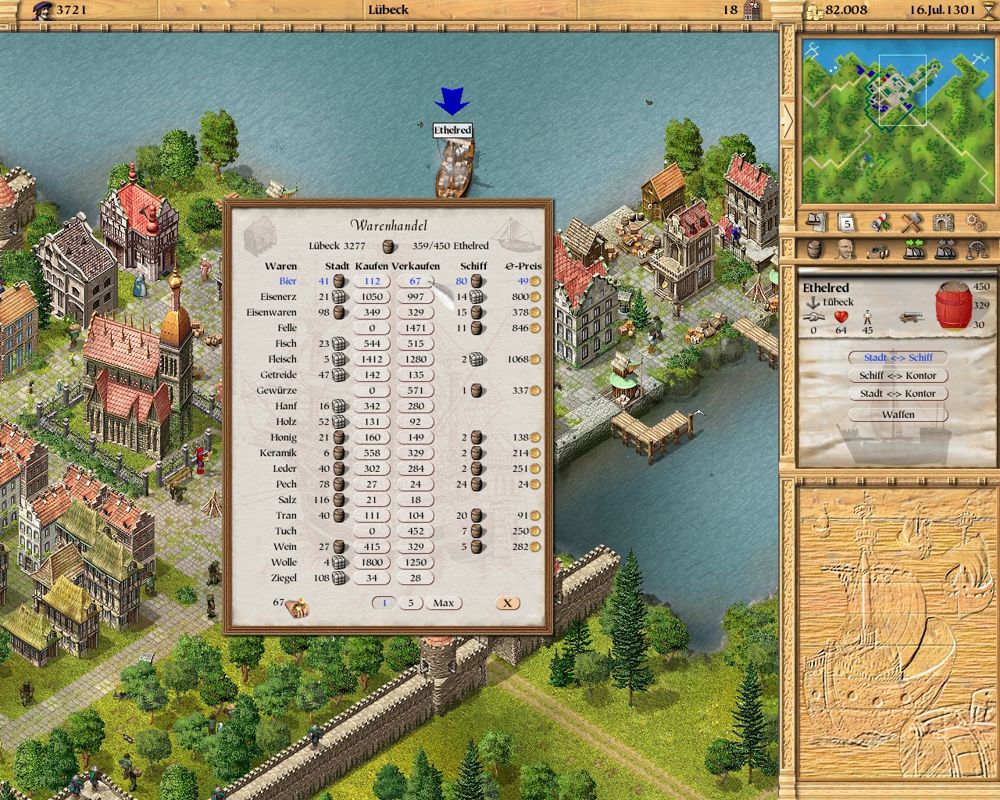Retro Replay Review
Gameplay
Patrician II: Quest for Power offers a deeply engaging blend of strategy and business simulation that immediately immerses you in the mercantile world of the Hanseatic League. You begin as a humble shopkeeper with a single ship, carefully balancing your initial capital between purchasing trade goods and upgrading your vessel. Each decision feels weighty—do you invest in cloth at one port, or is grain the wiser choice this season? This push-and-pull dynamic is at the heart of the gameplay loop, as you chase profit margins and build your reputation.
(HEY YOU!! We hope you enjoy! We try not to run ads. So basically, this is a very expensive hobby running this site. Please consider joining us for updates, forums, and more. Network w/ us to make some cash or friends while retro gaming, and you can win some free retro games for posting. Okay, carry on 👍)
As you expand your trading network, the game introduces political elements that add another strategic layer. Rising through the civic ranks—from shopkeeper to Lord Mayor and then Alderman—unlocks privileges like constructing workshops to boost local production. These workshops not only increase your trading potential but also force you to plan long-term supply chains and negotiate with town councils. Each promotion is a tangible marker of progress and keeps you motivated to push further into the Hanseatic hierarchy.
Naval encounters with pirates break up the routine of buying and selling with high-stakes action. You can choose to pilot your ships directly in real-time battles or let the computer resolve them automatically. This flexibility accommodates both players who relish tactical naval combat and those who prefer to focus on their merchant empire. Building and upgrading up to four vessels means you’ll constantly be refining your fleet composition—speedy traders to outmaneuver corsairs or armed galleons to hunt them down.
The inclusion of both single-player campaigns with customizable options and competitive multiplayer for up to eight participants ensures that Patrician II remains fresh. Whether you prefer hot-seat face-offs with friends, LAN showdowns, or internet skirmishes, the game scales to your preferred style of interaction. Multiplayer races to amass wealth or diplomatic alliances further enrich the gameplay, making every session and rival uniquely challenging.
Graphics
For a title released at the turn of the millennium, Patrician II’s visuals hold up surprisingly well, thanks to its attention to atmospheric detail. Town vistas shift with the seasons—autumnal hues blanket the trees in midsize trading centers, snow drifts accumulate on rooftops in winter, and bustling harbors gleam under a summer sun. These cyclical changes not only add aesthetic variety but also subtly influence your trading strategies, as port access and resource prices fluctuate.
Ship models are rendered with commendable clarity, and each upgrade—be it reinforced hulls or larger cargo holds—is immediately apparent on screen. The transition from in-port walking tours of your warehouses to animated sea lanes where vessels glide across the waves is seamless. Pirate ships, with their tattered sails and menacing black flags, stand out vividly, heightening the sense of danger when you venture into contested waters.
The user interface strikes a practical balance between providing crucial data and preserving screen real estate. Detailed trade windows display supply and demand curves, price histories, and inventory levels without overwhelming your view. Town maps and political status indicators are clearly labeled, making it easier to plan your next move. While the textures lack the high-definition polish of modern releases, the overall presentation remains functional and visually appealing.
Sound design complements the graphics, from the creaking of wooden decks to distant church bells signaling the hour. Ambient music, inspired by medieval folk tunes, blends into the background, ensuring that extended play sessions never feel repetitive. Together, visual and audio elements craft an immersive medieval trading simulacrum that enhances every strategic decision you make.
Story
While Patrician II doesn’t deliver a linear narrative in the traditional sense, it spins an emergent tale unique to each playthrough. You craft your own story as you negotiate with rival merchants, navigate the fickle politics of Hanseatic councils, and carve out new trade routes. This emergent storytelling is a strength, offering limitless replayability as no two merchant careers unfold in quite the same way.
The backdrop of the Hanseatic League provides historical authenticity, with real-world towns like Lübeck, Hamburg, and Riga featuring prominently. Each city has its own economic personality—some specialize in timber and furs, others in luxury textiles—forcing you to adapt your trading strategy accordingly. Political events and randomized pirate outbreaks further drive the narrative forward, prompting you to pivot plans on the fly and create personal milestones.
Your rise from modest shopkeeper to influential Alderman is underscored by satisfying role-playing elements. Gaining the trust of city councils, forging alliances with noble families, and leveraging your status to influence taxation or trade laws give the sense that you are an active participant in shaping Hanseatic history. This personalized journey feels far more compelling than a predefined storyline, allowing players to invest in their character’s legacy.
Even its smaller moments—such as receiving a courier’s letter offering a lucrative monopoly or witnessing rival guilds conspire against you—add color to the wider tapestry. Though the game won’t hold your hand with cutscenes or voiced dialogue, it trusts you to piece together your own saga from the cause-and-effect of strategic choices, making every victory all the more rewarding.
Overall Experience
Patrician II: Quest for Power stands out as a robust strategy and economic simulation that rewards patience, foresight, and adaptability. Its layered gameplay systems—from market speculation and workshop construction to naval warfare and political intrigue—offer a well-rounded experience that keeps ambition firmly in check with risk. Every decision feels consequential, and the satisfaction of watching your growing fleet skim prosperous trade routes is undeniably profound.
The game’s moderate learning curve may feel steep to newcomers unfamiliar with complex trading sims, but an intuitive interface and clear in-game prompts help ease the transition. Veteran strategists and history buffs will appreciate the depth of economic modeling and the period-accurate setting. Meanwhile, the flexible difficulty options and multiplayer modes ensure that Patrician II can cater to both leisurely solo players and competitive groups.
Even decades after its release, Patrician II retains a distinctive charm that few modern titles in the genre can match. Its focus on player-driven narratives, combined with a living, breathing economic sandbox, fosters a highly replayable environment. If you’re seeking a strategy game that goes beyond warfare to explore the subtleties of commerce and diplomacy, this medieval trading epic is well worth your time.
Overall, Patrician II delivers an engrossing merchant adventure that balances strategic depth with immersive world-building. Its engaging gameplay loops, atmospheric graphics, and emergent storytelling combine to create a timeless experience that continues to captivate ambitious traders and history enthusiasts alike.
 Retro Replay Retro Replay gaming reviews, news, emulation, geek stuff and more!
Retro Replay Retro Replay gaming reviews, news, emulation, geek stuff and more!









Reviews
There are no reviews yet.